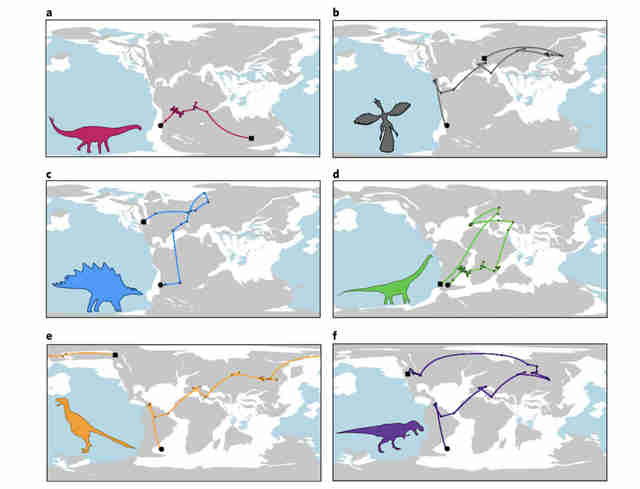The evolutionary histories of dinosaurs and viruses have more in common than one might expect. And a new method for studying the animals is already being recruited in the fight against influenza and additional viruses that can infect humans and other species. The groundbreaking technique is described in the journal Nature Ecology & Evolution.
The breakthrough involves projecting shifting rates of evolutionary change onto the surface of a sphere, instead of on a flat plane. This allows biogeographical data to be analyzed within an Earth-resembling model that captures speed, direction, and distance moved over short to long periods of time.
"As long as a group of organisms can be placed in a phylogenetic tree, which describes how species are related to each other, or a single species of interest can be placed in the context of its close relationships within a phylogenetic tree, and has geographical data — longitudes and latitudes of where the organisms have occurred on the Earth — the method we develop can reconstruct where the organisms’ ancestors existed on the globe," co-author Andrew Meade of the University of Reading told Seeker.
On the dinosaur side of the research, the technique has already revealed new insights concerning the origin and dispersal of dinosaurs.
Meade, lead author Ciara O'Donovan, and senior author Chris Venditti plugged extensive information on dinosaurs and their fossil record into their model. The data came from the Paleobiology Database, an online resource curated by numerous scientists around the world.
The information shows that dinosaurs first evolved in what is now South America at close to the beginning of the Mesozoic Era, which lasted in its entirety from about 252–66 million years ago.
"Prior to the dinosaurs’ origination there was an extreme extinction event," O'Donovan told Seeker. "This happened 252 million years ago, at the Permian-Triassic boundary and is the largest extinction event to have occurred in Earth’s history."
"This decimated the majority of life on Earth and therefore may well have provided the dinosaurs with a blank canvas to colonize," she added. "This fairly ‘empty Earth’ would have been totally open and up for grabs, and the dinosaurs were able to spread across the globe quickly, taking every ecological opportunity in their path."
Pangea — the single, giant landmass that later broke up to form the continents — was additionally whole when the dinosaurs originated about 231 million years ago. This meant that there were few, if any, geographical barriers preventing the dinosaurs' movement.
O'Donovan and her team suspect that the dinosaurs must have had some beneficial biological predisposition, enabling them to take advantage of the "blank canvas" they found themselves on. This aided their moving, dispersing, and colonizing new habitats. The remains of dinosaurs have remarkably been found on every continent, from what are now the polar regions to nearly every place in between.
The researchers tracked the movements through evolutionary time of the four major groups of dinosaurs — Ornithischians, Sauropods, Theropods, and birds — as well as certain individual species, like Tyrannosaurus rex.
The researchers determined, however, that all of the animals shared a rapid initial expansion whereby the dinosaurs speciated quickly and moved over great distances. This was followed by a continual and gradual slow-down as the animals approached the critical Cretaceous-Tertiary boundary 66 million years ago.
Venditti explained: "As time went on, dinosaurs both moved less, and fewer new species were produced. The less they could move, the more likely it would have been that any speciation that did occur would be by specialization in the environment the dinosaurs were already living in."
"The idea that the dinosaurs were running out of space fits here," he continued. "The lack of space explains why the dinosaurs were less able to speciate to replace species that were going extinct. And species may have been going extinct owing to becoming specialized and therefore being vulnerable to changes within the environment."
The new information supports the conclusions of a prior University of Reading study that was published in 2016 in the journal Proceedings of the National Academy of Sciences. It found that 50 million years before the asteroid impact that occurred in the Yucatan peninsula 66 million years ago, dinosaurs were already in decline.
Nevertheless, the ancestors of today's birds survived.
"Where avian ancestors were not able to move to new environments owing to the lack of space by that time, they specialized to take advantage of a type of space previously unoccupied by dinosaurs — aerial space," O'Donovan said. "They were able to do this because they had feathered wings. In doing this, they would have been able to explore ecological opportunities that were previously inaccessible and would have been able to evade competition with their relatives on the ground."
It is possible that birds benefitted from the die-off in the same way that non-avian dinosaurs did after the Permian-Triassic extinction event.
 |
| Fossil of Archaeopteryx lithographica, excavated in southern Germany |
The model can be applied to anything for which a certain amount of ancestral history is known. On a small scale, and considering the current popular technologies related to DNA, it could reveal the geographical signature of an individual family over time.
Meade said that the technique could also "be useful in the case of viruses, or perhaps plants linked to agriculture or invasive species if we wish to know where a certain virus originated, or how quickly a plant has spread or a species has invaded non-native environments."
The model could also show far more than the history of one particular human family.
"It is also possible to represent human cultures in a phylogenetic tree by using similarities and differences in language," Meade explained. "This means it would be possible to study the expansion of humans across the planet using our approach."
Read more at Seeker


No comments:
Post a Comment